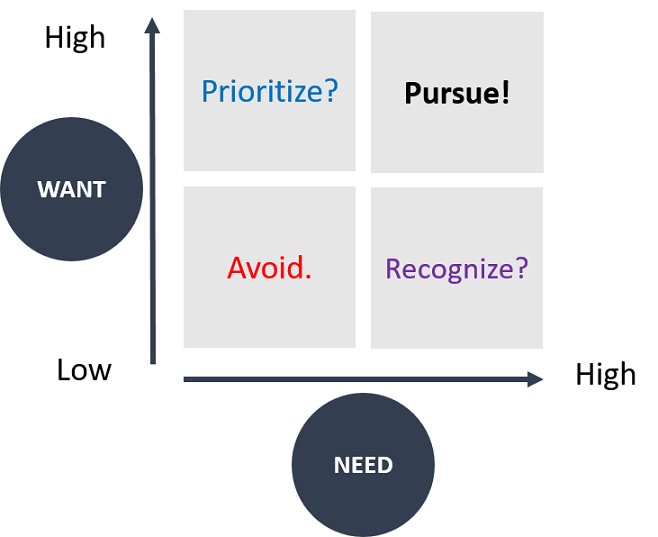A quadrant based prioritization approach
Wants and needs are two different words whose meanings are both well understood and also conveniently interchanged ? depending on our desires and motivations. Deconstructing the interplay between these words is key to better understanding ourselves.
 Unsplash
Unsplash
A quick Google search of the definitions of ?want? and ?need? show the following as the first result:
Want ? have a desire to possess or do (something); wish for.
Need ? require (something) because it is essential or very important rather than just desirable.
The definitions reflect how we commonly distinguish between these terms. The distinction centers on one quality ? ?essential?. Of course, how we define ?essential? is subjective!
When we are the sole decision maker, then we are the sole determiner of what is essential. When we are deciding within a group, there are often some formal frameworks that help us prioritize. A popular model is the MoSCoW which represents Must have, Should have, Could have or Won?t have. It is often used to prioritize requirements for systems development, but can be readily applied to many other contexts.
In essence, it is a priority scale that helps distinguish, in descending order, the ?essential? ?need from ?desirable? wants.
We can apply a similar categorization to our personal lives by employing a 2×2 matrix, which is a visual, simple and yet powerful model for illustrating options.
The Grid
When we plot our Wants and Needs in a grid, our decision-making is given a new dimension ? no pun intended. We can visualize the interplay between wants and needs, understand the permutations and tailor our thinking accordingly.
 Wants vs Needs ? prioritization matrix
Wants vs Needs ? prioritization matrix
Low Want /Low Need
We start with the bottom left ? traditionally the quadrant with the relatively ?worst? option. In our case, this is Low Want and Low Need. Things in this quadrant can be safely ignored. While this may seem obvious, we can often be trapped into mindlessly pursuing (read: wasting time on) worthless things ? ones we don?t really want and definitely don?t need.
Once something is definitely identified as belonging to this quadrant, the action is to Avoid. Full stop.
Low Want / High Need
We now get into the twin diagonal quadrants, which are effectively mirror images of each other. This quadrant is the trickiest one to understand. Items for which we have a Low Want but High Need, are often not apparent. We may discard an option superficially not knowing its true worth. Or indeed we may arbitrarily put off an option, despite it being essential. A typical example is a task that is boring or laborious in itself, yet is a pre-requisite for an important higher goal e.g. procrastination for going to the gym etc. Life?s greatest opportunities often come disguised in this quadrant ? as something we need at a deep level but seem to have a low want for on the surface.
Once something is identified in this quadrant, the key is to remind ourselves of the higher goal at hand and prioritize accordingly.
High Want / Low Need
This is probably the quadrant we are faced with most often and therefore the most important. The items belonging here are the ones we typically question using: ?do we really need that [insert item]??. This quadrant typically includes items or ?requirements? that are attractive yet ultimately superfluous.
Once something is identified in this quadrant, we need to decipher what we really value and what we don?t.
High Want / High Need
The top right quadrant represents the ideal scenario. This is the most powerful quadrant. When our wants and needs are aligned, we have high motivation to pursue such desires or prioritize for such items. The key is assessing if our wants are truly our needs. Often we can, disguise wants as needs and can trick ourselves into justifying these.
The key to resolving this quadrant is to ?look before you leap?. Having wants and needs in alignment is the ideal and most efficient scenario but it pays to just double-check before pursuing with vigor.
The Journey
A quadrant based approach to wants and needs finds many uses. We can use it to evaluate personal desires, system requirements, product features or indeed even our relationships with people. We can even change the axes from High/Low to High/No or add an intermediate column for ?medium? depending on how fine-grained we want our evaluation to be.
So far, I?ve mainly used it for evaluating product features and personal goals. A curve ball to this approach comes in the form of items or desires that have an aesthetic tinge or some other intangible or peculiar value. In such cases, we may discover that what we felt was Low Need is actually a High Need. Over time, our want and needs will change. In reality, like life, the quadrants are dynamic and not static. As our definition of essential changes, so does our categorization. But while what we place in each quadrant may change, our strategy for resolving the quadrants would remain constant. This is because the master key to resolving all the quadrants lies in our judgement, and subsequent prioritization, of ?value?.
In the end of the day, we don?t evaluate products, items or desires. Every time we evaluate something or perhaps even someone, we actually analyze and discover a different aspect of ourselves, our desires and our values.
When we consciously start to separate the wheat from the chaff, we begin the crucial journey of understanding ourselves better.


